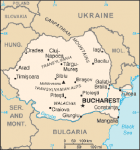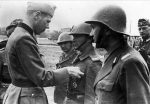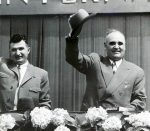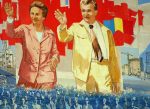
Romania was another eastern European nation that fell to socialism after being occupied by the Soviets during World War II. Romania’s story, however, differs from that of its Soviet bloc neighbours. For most of the Cold War, Romania was ruled by two devotees of Joseph Stalin. Gheorghiu-Dej transformed Romania into a tightly controlled Stalinist state, forming a secret police agency, building prison camps and fast-tracking industrialisation. But the death of Stalin and the rise of Nikita Khrushchev opened a rift between Moscow and Bucharest. Romania then began to steer its own course, moving away from Soviet influence and establishing ties with the West, while retaining Stalinist economic systems and power structures. Gheorghiu-Dej died in 1965 and was succeeded by Nicolae Ceausescu, who ruled Romania for the next 24 years. Ceausescu’s leadership, economic policies and social experiments were unrealistic and dangerous, bringing two decades of suffering and misery to the Romanian people.
Romania is a small country with a diverse population and a rich history. It became a nation-state in 1881, after gaining independence from the Ottoman Empire. Before this Romania’s territory was occupied by three medieval principalities: Moldavia, Wallachia and Transylvania. Sandwiched between Russia, Austria and the Balkans, this region had long been a battleground for imperialists, warlords and nationalists. Perhaps the most famous of these of warlords was the Wallachian prince Vlad III (1431-1477), better known to history as Vlad the Impaler. From the 17th century, much of Romania’s territory was ruled by the Ottoman and Austro-Hungarian empires. Nationalist movements grew and mobilised in the early 1800s, leading to attempted revolutions (1848) and the Romanian War of Independence (1877-1878). Romania was finally granted independence in 1881, becoming a constitutional monarchy. It fought alongside the Allies in World War I and was invaded and occupied by Germany in 1916-17. The Allied victory in 1918 saw Romania almost double in size, after receiving territory from Hungary and Russia. During the interwar period, Romania became one of Europe’s most prolific sources of oil and food.

Like many other European nations, Romania in the 1930s was beset by economic problems and political instability. In February 1938 King Carol II suspended the constitution and ruled using emergency powers. He set about reforming the country as an authoritarian dictatorship, while cautiously forging an alliance with Adolf Hitler. Carol was overthrown by fascists in September 1940 and, two months later, Romania entered World War II alongside Nazi Germany. Romanian troops participated in Operation Barbarossa, Hitler’s invasion of the Soviet Union in 1941. Later, Romania came under attack from Allied planes and Soviet ground troops. The Romanian government changed hands again in August 1944 as Soviet forces invaded from the east. By mid-September the Red Army controlled most of the country, forcing the new government to sign an armistice. By the end of 1945, Romania had been occupied by around one million Soviet troops.

As they did elsewhere, the Soviets actively interfered in Romania’s post-war reconstruction, preventing the formation of a coalition government and installing communists like Gheorghiu-Dej and Ceausescu in key positions. National elections were held in November 1946 but were almost certainly rigged, the tiny Romanian Communist Party (Partidul Comunist Român, or PCR) receiving almost 90 percent of the vote. By 1948 Romania had an explicitly Stalinist government dominated by Gheorghiu-Dej. The new regime drew closer to Moscow, Romania joining COMINFORM, COMECON and, later, the Warsaw Pact. Gheorghiu-Dej developed and expanded Stalinist methods of control, including a brutal secret police force (the Securitate) and a network of prison and labour camps. His regime implemented Stalinist economic policies, particularly the forced collectivisation of agriculture and rapid industrialisation. The ranks of the government were filled with pro-Soviets, while churches and other political groups were suppressed.
The rise of Nikita Khrushchev and Khrushchev’s denunciation of Stalin’s methods (1956) saw Romania back away from its reliance on the Soviet Union. Committed to his own brand of Stalinism, Gheorghiu-Dej began to refuse advice from Moscow, developing his own economic and foreign policy. The Romanian leader forged alliances with communist China, Tito’s Yugoslavia and North Korea. He even sought trade deals with Western nations, particularly Britain, France and West Germany. When Gheorghiu-Dej died in March 1965 his successor, Nicolae Ceausescu, continued to act independently. In 1968 Ceausescu criticised Moscow’s military response to the Prague Spring, refusing to send Romanian troops and condemning the Warsaw Pact for its heavy-handedness:
“The incursion in Czechoslovakia of the troops belonging to the five socialist countries represents a big mistake and a serious threat to peace in Europe and for the destiny of socialism in the world. It is inconceivable in the present day world, when peoples rise to defend their national independence and for equal rights, that a socialist state infringes on the liberty and independence of another state. There can be no excuse, and there can be no reason to accept, even for a single moment, the idea of military intervention in the domestic affairs of a fraternal socialist state.”

This anti-Soviet defiance boosted Ceausescu’s popularity, both in his own country and in the West. Though still a communist, Ceausescu was seen as a free-thinking maverick who was not under the heel of Moscow. During the 1970s the Romanian leader visited many Western nations and met several heads of state, including US president Richard Nixon and Britain’s Queen Elizabeth II. Romania also established diplomatic relations with Western countries, recognised West Germany as a sovereign state and signed trade agreements with European nations. Ceausescu also visited and bonded with the leaders of other communist nations, particularly China, North Vietnam and North Korea. This contact only strengthened his commitment to Stalinist economics and systems of government. In 1974 Ceausescu consolidated his power by creating an executive presidency; he would be elected to this office for the next 15 years. Elevation to the presidency increased Ceausescu’s power considerably and allowed him to rule as a de facto dictator. He set about building a cult of personality, modelled on that of North Korean dictator Kim Il Sung.

Romania’s rapid decline in the 1970s and 1980s is one of the Cold War’s great tragedies. Ceausescu harboured nationalist ambitions that were grandiose and unrealistic. Hoping to develop Romania as a major European power, Ceausescu borrowed heavily to build a network of oil refineries. When these refineries failed to produce the expected profits, Romania was saddled with an enormous foreign debt (more than $US10 billion in 1981). To pay down this debt, Ceausescu exported food, industrial goods and electricity, while imposing strict rationing on his own people. Crop failures and devastating earthquakes in the mid-1970s only added to their misery. Romanian women suffered particularly heavily. One of Ceausescu’s objectives was to arrest a decline in the birth rate and increase Romania’s population from 25 million to 30 million. This gave rise to one of the 20th century’s most pervasive attempts at social engineering. In the late 1960s, the government issued Decree 770, a law prohibiting contraception and abortion. Romanian women were subject to compulsory monthly examinations by state doctors (the so-called “menstrual police”). Pregnancies were recorded and supervised to completion; women who miscarried were investigated for suspected abortion; women who failed to conceive were interrogated about their personal life and sexual habits. Forced to bear children in impoverished conditions, many Romanian women turned to backyard abortions, and tens of thousands died in the process.
“Some intellectual endeavour was devoted to finding a formula that described the peculiarity of the Ceausescu regime in the 1970s and 1980s. For some it was a primitive Stalinism. Others added a touch of Byzantine tradition to the classical communist totalitarianism; and still others spoke of an ersatz society, a pseudo-neo-Stalinism. There might have been all these ingredients, although in the end it looked in many respects like pure madness.”
Nestor Ratesh, Romanian writer
As the Romanian people suffered, Ceausescu and his inner circle lived in extravagant surroundings. Ceausescu himself owned numerous houses around the country, mostly grand mansions or estates tended by servants. Ceausescu’s wife Elena collected expensive furs, designer clothing and jewellery, while their son Nicu enjoyed expensive cars and imported foreign whisky. Ceausescu filled cabinet, government and diplomatic positions with his relatives, appointing his wife Elena to the Politburo (1973) and later making her deputy prime minister (1980). Together the pair pilfered vast amounts from Romania’s national treasury, hiding it in bank accounts offshore; the true amount stolen is unknown but may be close to $US1 billion. Ceausescu’s popular support dwindled in the 1980s, marked by a series of strikes and protests, many of which were brutally shut down. With a revolution brewing, Ceausescu delivered his final speech in Bucharest in December 1989. Violence broke out in the crowd, forcing Ceausescu and his wife to flee. They were soon captured, arrested and given a show trial, before being executed by firing squad on Christmas Day.

1. Romania is a small nation in eastern Europe. After siding with the Nazis in World War II, Romania was occupied by the Soviets, who installed a communist government.
2. For most of the Cold War, Romania was ruled by Stalinists, who attempted rapid industrialisation and collectivised farming, while using repressive social controls.
3. Romania’s leader, Gheorghe Gheorghiu-Dej, severed ties with Moscow after the death of Stalin, adopting an independent foreign policy and negotiating with the West.
4. Nicolae Ceausescu continued this approach, opposing the Soviet reaction to the Prague Spring. This increased his popularity, both within Romania and around the world.
5. Ceausescu’s economics, social policies and corruption inflicted enormous suffering on the Romanian people, however, and he was overthrown and executed in December 1989.
Content on this page is © Alpha History 2018-23. This content may not be republished or distributed without permission. For more information please refer to our Terms of Use.
This page was written by Jennifer Llewellyn and Steve Thompson. To reference this page, use the following citation:
J. Llewellyn & S. Thompson, “Romania under Ceausescu”, Alpha History, accessed [today’s date], https://alphahistory.com/coldwar/romania-under-ceausescu/.
